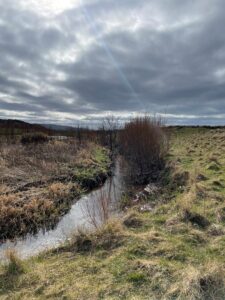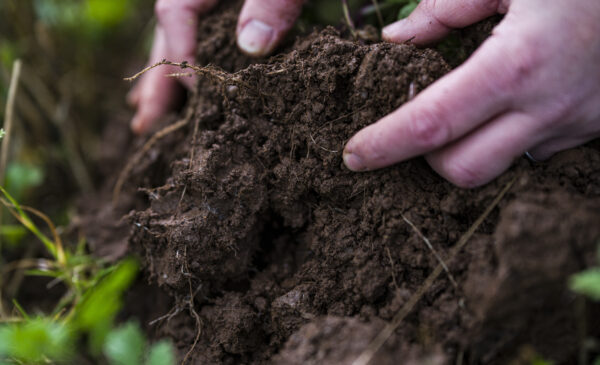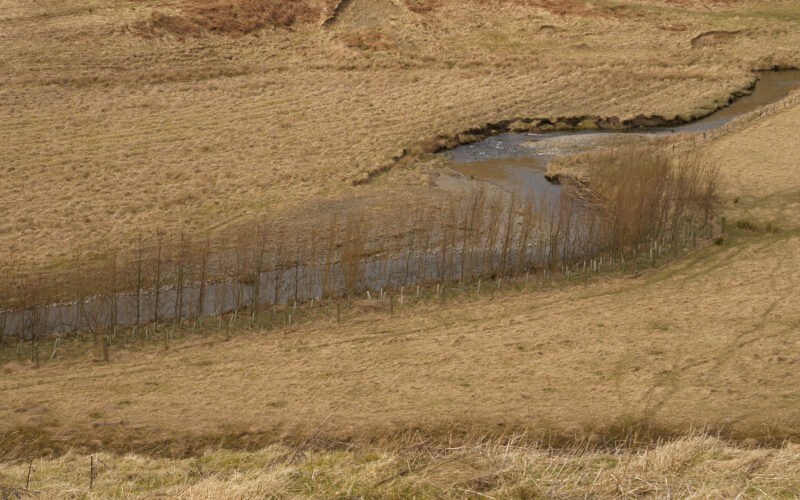Scotland’s rivers are facing increasing challenges due to more frequent and intense flood events. As observed during Storm Frank in December 2015, severe flooding can lead to significant riverbank erosion, threatening vital infrastructure and agricultural land.
In response to this growing concern, river practitioners and landowners in Scotland are turning to an innovative, environmentally friendly solution: sustainable bank protection using living trees and vegetation.
While traditional bank protection techniques often rely on hard materials like rock and gabions, these structures can cause additional erosion by reflecting energy back into the river. In contrast, a pioneering approach being trialled in Scotland draws inspiration from successful practices in the Lake District, where natural methods using trees and plants have been shown to effectively reduce erosion. By using trees, vegetation, and natural materials, the approach creates flexible, energy-dissipating barriers that move with the flow, rather than reflecting the force of the water, so are less likely to be undermined or cause erosion elsewhere.
Working in partnership with the National Farmers Union Scotland (NFUS), the Scottish Environment Protection Agency (SEPA) have introduced this method to riverbanks across the country. Eight test sites were chosen, from larger rivers like the Don at Dyce to smaller, more volatile streams in Newcastleton and Teviothead. At these sites, various techniques were tested, such as creating woven willow walls, pinning large trees to the bank and burying trees with attached root wads into banks at higher-energy locations.
The results have been overwhelmingly positive. After more than six years, the sustainable protection at these sites has proven to be highly effective, with only one location failing due to installation errors.
Landowners whose properties have benefited from these methods have reported strong success, noting that the natural protection has stopped bank erosion and even encouraged sediment deposition in front of the banks, further stabilising the area. Additionally, all sites withstood significant flood events since the installation of natural riverbank protection.

Addressing the challenges of riverbank erosion
The success of these trials highlights the potential for trees and vegetation to play a central role in addressing the challenges of riverbank erosion. Not only do they reduce the risk of erosion during flood events, but when used in combination with planting trees on the banks they also promote biodiversity, enhance water quality, and create more resilient ecosystems.
The trials served to highlight several key features that underpin a more sustainable approach to bank protection. For example, in higher-energy, more mobile rivers, certain methods were found to be essential for ensuring long-term bank stability:
- Solid base protection: Large trees or root wads should be positioned at the bottom of the bank (bank toe) to provide solid support and prevent erosion. These materials act as an anchor, holding the bank in place against the force of the water.
- Energy dissipation: A rough face of branches, roots, and other natural materials is vital in dissipating the energy of the flowing river, reducing the erosive power of the current. This helps to avoid the reflection of energy that can lead to further erosion, which is a common issue with traditional hard protection methods.
- Vegetation for long-term protection: Willow and other trees should be planted along the top of the bank to provide long-term, natural protection. These plants help stabilise the bank over time and regenerate if damaged, ensuring continued protection during future flood events.
Among the tested techniques, large trees pinned to the bank toe proved to be the most effective and cost-efficient method, as they required fewer trees compared to installing root wads. Meanwhile, willow spiling and brash techniques performed exceptionally well on lower-energy systems, where the river’s force is less intense.
For the long term, fencing and planting riparian corridors – vegetated buffers along riverbanks – are seen as the best strategy for reducing channel erosion. These vegetated banks are far more resilient to erosion during large flood events, providing a sustainable, natural defence against riverbank loss.
An innovative, green and cost-effective approach
Sustainable bank protection not only provides significant environmental benefits, but it also offers a cost-effective alternative to traditional methods. Depending on the technique used, per metre costs can range from £27 for whole trees and £75 for root wads up to £1,000 per metre for the more commercial root wad examples. The more affordable examples are where many materials were sourced locally or from the land itself.
Comparatively, traditional hard protection methods can cost upwards of £220 per metre. The potential savings, combined with the long-term benefits of enhanced biodiversity and flood resilience, make this an attractive option for landowners across Scotland.
Landowners interested in learning more about sustainable bank protection can find more information on SEPA’s website and read SEPA’s Best Practice Design Guide. The guide provides detailed advice on how to design and install sustainable bank protection tailored to different types of rivers. It also includes instructional videos and case studies from the trial sites, offering valuable insights for landowners interested in implementing these methods.
Related resources

Catchment Management Plans – why are they important?
Here Ann-Marie MacMaster, Land Use and Nature-Based Solutions Project Officer with The River South Esk Partnership explains more.
Catchment management plans bring together all aspects of the water environment. They take into account…

Sustaining Scottish soils
Sarah Buckingham, SAC Consulting
The importance of soils Soils underpin all nature-based systems, therefore, are vital in supporting Scotland’s…

Pit silage Vs. Bales
Fiona Salter, SAC Consulting and Robert Hunter, West Tarbrax Farm
Making and storing silage is an expensive operation. How you choose to store silage needs…

